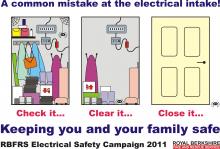How safe is your electrical intake – are you at risk of a fire in your home or business premises?
How safe is your electrical intake - are you at risk of a fire in your home or business premises?
The campaign, which runs until the end of October, covers the entire county and is supported by a grant from the Electrical Safety Council (ESC), a UK charity committed to reducing deaths and injuries caused by electrical accidents at home and at work.
Electrical intake equipment can carry high electrical loads which generate heat and the wiring consists of a series of connections between supply and distribution cables. These also generate heat and, even if your connections are sound, could create an ignition source to start a fire.
The risk of a fire starting and developing is increased if household items are stored too close to these intake areas. These items suppress the amount of heat exchange that is required in the wiring and may also cause damage which could loosen connections, leading to arcing and sparking when under load. Such items could also contribute to the development and spread of fire.
The fire hazard this creates is greater if the electrical intake position is situated on or near an escape route, as even a small fire will create a large amount of toxic smoke very quickly, preventing a safe escape.
People are being advised to inspect their service intakes (in domestic properties, this contains the supply cut-out fuse, meter and consumer unit)and to ‘Check It, Clear It, Close It’:
CHECK the electrical service intake for signs of damage
Keep area around the electrical service intake CLEAR of combustible material
CLOSE the door if housed in a cupboard
Ensure you have an adequate number of correctly sited and working smoke detectors
RBFRS Group Manager Chris Bunyan said: “Nationally, there is a rising trend of fires being attributed to overheating of the electrical intake fuse unit. As a fire and rescue service, we have no control over electricity supply companies but we are tasked with minimising the impact of such fires.
Typically fuse units are located in cupboards under the stairs which get filled with combustible materials like coats, ironing boards and other household items. The campaign is being timed to coincide with increased energy supply and associated risk with the change of season.
Our message to residents is to know where their electrical intake is located, ensure that the area is kept clear of combustibles, as without fuel any overheating or sparks will be less likely to start a fire. If it’s in a cupboard, keep the door shut to contain any fire that does start and, very important, install a smoke alarm close by for early warning. This is particularly vital if the cupboard is on an escape route eg under the stairs. The grant from the ESC has meant that we can take our road show out to spread the word and advise people how to ensure their intake is safe.”
For more information on event dates visit www.esc.org.uk

